art4d SPEAKS WITH NARAWAN PATHOMVAT AND KANOKWAN TRAKULYINGCHAROEN ABOUT THE OCCURRENCE OF LIGHTBOX THAT BROUGHT THE THAI ART SCENE’S ATTENTION TO THE BACC
TEXT & PHOTO: NAPAT CHARITBUTRA
(For English, please scroll down)
การแลกเปลี่ยนวัฒนธรรมระหว่างประเทศไทยและอิตาลีเกิดขึ้นมาอย่างต่อเนื่องและในหลายๆ รูปแบบ ย้อนกลับไปได้ตั้งแต่ช่วงรัชสมัยของพระบาทสมเด็จพระมงกุฎเกล้าเจ้าอยู่หัว ที่สยามได้ส่งศาลาไทยไปร่วมจัดแสดงในงาน Turin International ปี 1911 ก่อนที่จะพยายามนำไอเดียการจัดงานในลักษณะเดียวกันนี้มาจัดที่ทุ่งศาลาแดง (ปัจจุบันคือสวนลุมพินี) ถัดขึ้นมาจนถึงในยุคที่พอจะอยู่ในความทรงจำของคนทั่วไป อย่างการที่รัฐบาลไทยนำความเป็นไทยไปโชว์ให้นานาชาติได้เห็น ไม่ว่าจะผ่านศาลาไทยใน Venice Biennale ครั้งที่ผ่านมาที่ใช้ชื่อตรงๆ ว่า KRUNG THEP BANGKOK (โดย สมบูรณ์ หอมเทียนทอง) หรือในปี 2009 ที่ทำให้พาวิลเลียนเป็นเหมือนกับ travel agency เชิญชวนให้คนมาเที่ยวเมืองไทยในชื่อ Gondola al Paradiso Co., Ltd. รวมถึงเมื่อเร็วๆ นี้ที่มีการนำกิจกรรมแบบ “ไทยๆ” อย่างตลาดน้ำ มวยไทย และนวดแผนไทย ไปจัดที่ Pescheria di Rialto ควบคู่ไปกับงานเปิดของ Venice Biennale of Architecture 2018 ในทางกลับกัน รัฐบาลอิตาลีก็นำความเป็นอิตาลีกลับเข้ามาแสดงในไทยด้วยเช่นกัน ในวาระเฉลิมฉลองครบรอบ 150 ปีการสถาปนาความสัมพันธ์ทางการทูตระหว่างประเทศอิตาลีและประเทศไทย โดยการจัดนิทรรศการ Caravaggio OPERA OMNIA ขึ้นที่ หอศิลปวัฒนธรรมแห่งกรุงเทพมหานคร เมื่อช่วงต้นเดือนพฤษภาคมปีที่แล้ว
ไม่ใช่เรื่องแปลกใจและคาดเดากันได้ว่าการนำความเป็นไทยออกไปโชว์ให้นานาชาติเห็นก่อให้เกิดกระแสการวิพากษ์วิจารณ์ในประเทศ ไม่ว่าจะเป็นวิธีการนำเสนอ เนื้อหาของความเป็นไทย ที่หลายๆ คนมองว่า ตลาดน้ำ มวยไทย ฯลฯ ดูจะเป็นความเป็นไทยแบบ “สำเร็จรูป” ที่ให้แค่ภาพความเป็นไทยแบบผิวเผิน แต่ที่เกินความคาดหมายก็คือนิทรรศการ Caravaggio OPERA OMNIA ที่ว่าด้วยวัฒนธรรมของอิตาลีกลับก่อให้เกิดการวิพากษ์วิจารณ์ในวงกว้าง ผู้คนในวงการศิลปะหลายๆ คนออกมาวิจารณ์ถึงคุณภาพการพิมพ์ โดยเฉพาะวิธีการจัดแสดงงานแบบ lightbox ว่าไม่สามารถจำลองลักษณะฝีแปรงได้จริงๆ ขณะเดียวกันคนอีกกลุ่มหนึ่งก็ออกมาพูดถึงข้อดีด้านอื่นๆ ของนิทรรศการในฐานะสื่อการเรียนการสอนที่ดีสำหรับการเรียนการสอนประวัติศาสตร์ศิลปะในไทย จนกระทั่งเกิดการแบ่งฝักแบ่งฝ่าย เกิดเป็นคำแบ่งแยกอย่างลัทธิฝีแปรง / ลัทธิตู้ไฟ และลุกลามมากไปกว่านั้นเมื่อมีสำนักข่าวออนไลน์สำนักหนึ่ง ออกมาโจมตีการจัดแสดงบนตู้ไฟที่ว่านี้ด้วยการจัดนิทรรศการคู่ขนานขึ้นมา ลงทุนพิมพ์ภาพจิตรกรรมของ Vincent van Gogh ให้คนได้เปรียบเทียบคุณภาพของการพิมพ์กัน และประกาศต่อสาธารณะว่าภายหลังจากจบนิทรรศการ (ระยะเวลา 3 วัน) พวกเขาจะมอบงาน HD Digital Painting ตามแบบฉบับของเขาให้กับหอศิลปวัฒนธรรมแห่งกรุงเทพมหานคร และสถานทูตอิตาลี
ท่ามกลางความขัดแย้งที่ว่า art4d จึงเชิญ นราวัลลภ์ ปฐมวัฒน จากห้องสมุดศิลปะร่วมสมัย The Reading Room และอดีตอาจารย์พิเศษภาควิชาประวัติศาสตร์ศิลปะ คณะโบราณคดี มหาวิทยาลัยศิลปากร และกนกวรรณ ตระกูลยิ่งเจริญ นักประวัติศาสตร์สถาปัตยกรรมร่วมสมัย และอาจารย์ประจำ Institute for Architectural Theory, History and Heritage Preservation คณะสถาปัตยกรรมศาสตร์ มหาวิทยาลัยแห่งอินส์บรูก ผู้มีความคุ้นเคยกับศิลปวัฒนธรรมของอิตาลีมากว่า 10 ปี มาพูดคุยกันถึงปรากฏการณ์ที่ว่า และเพื่อต่อยอดประเด็นอื่นๆ ที่แวดล้อมนิทรรศการ Caravaggio OPERA OMNIA ที่อาจจะถูกการสาด hate speech ใส่กันไปมาอย่างที่กำลังเกิดขึ้นในปัจจุบันกลบทับไป
*บทสนทนาเกิดขึ้นในวันที่ 10 พฤษภาคม 2561
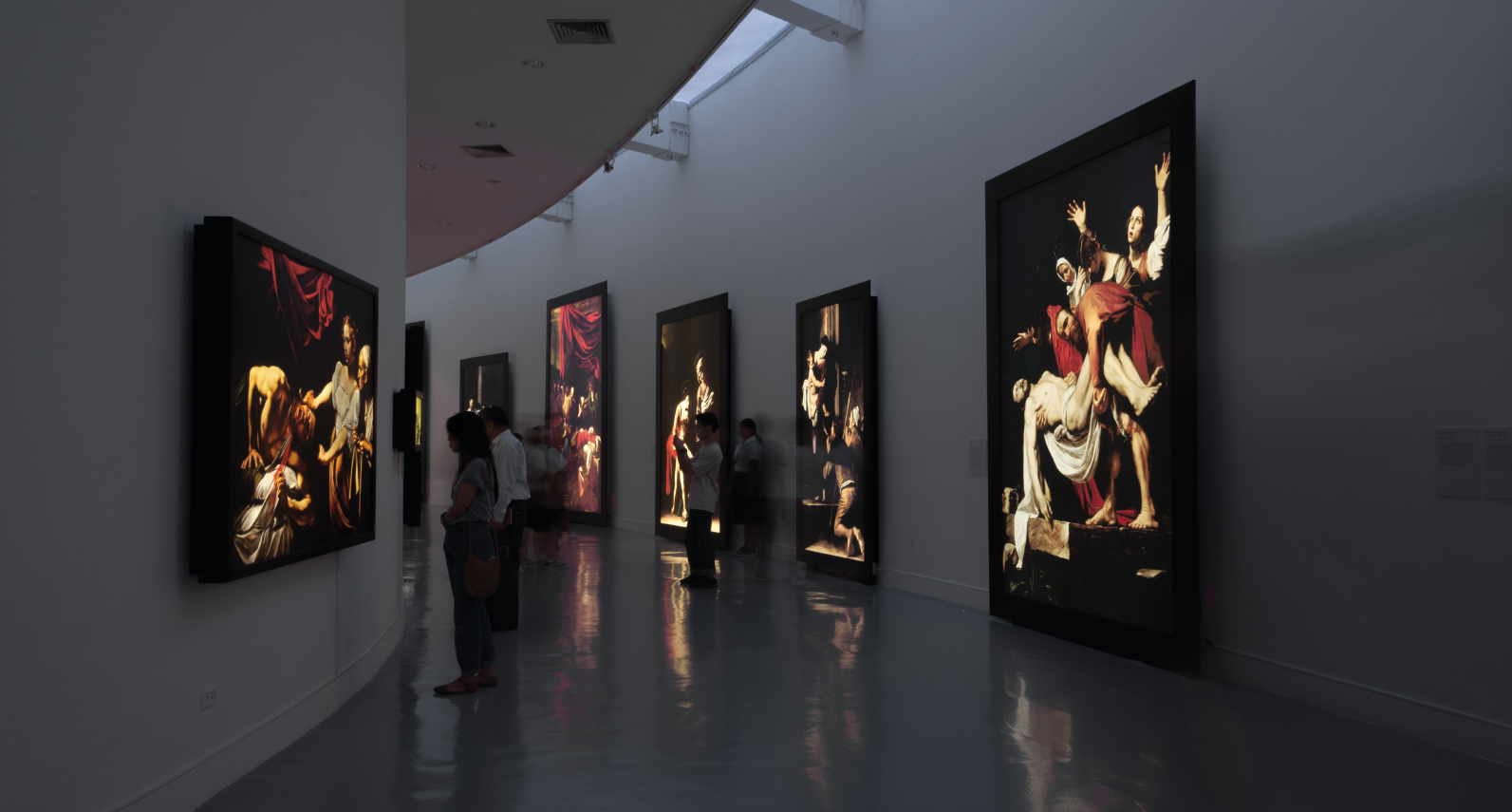
art4d: คิดเห็นอย่างไรที่มีคนออกมาโจมตีนิทรรศการนี้ โดยเฉพาะในประเด็นการไม่นำผลงานจริงมาจัดแสดง
Narawan Pathomvat: เราเข้าใจว่าในมุมมองของคนกลุ่มหนึ่ง โดยเฉพาะศิลปินหรือนักปฏิบัติ ความเป็น original ของงานศิลปะนั้นเป็นปัจจัยที่มีความสำคัญมาก ซึ่งก็เป็นเรื่องที่เข้าใจได้ งาน original มันย่อมมีความพิเศษ ความเป็นหนึ่งเดียว มีออร่าที่งาน reproduction ไม่มี แน่นอนว่าเราเห็นด้วยอยู่แล้วว่า ถ้านำงาน original มาได้มันย่อมดีกว่างาน reproduction แต่ในกรณีนี้ยังไงการนำงานจริงมามันก็เป็นไปไม่ได้ เราจึงควรตัดสินนิทรรศการที่ปัจจัยอื่นไม่ใช่ในเรื่องว่าทำไมไม่นำของจริงมา ไม่อย่างนั้นเถียงกันอย่างไรก็ไม่จบ ซึ่งในฐานะคนเคยเรียนและเคยสอนประวัติศาสตร์ศิลปะ เราค่อนข้างจะเห็นประโยชน์ของงาน reproduction อยู่มาก งานศิลปะหลายงานที่เรารู้จักและเรียนกันตามตำราประวัติศาสตร์ศิลปะ ก็เป็นงานก็อปจากงานจริงที่สูญหายไปหมดแล้ว อย่างงานศิลปะกรีกนั้นเรารู้จักมันได้ก็จากงานก็อปปี้สมัยโรมันหมดเลยนะ หรือในยุคก่อนจะมีสิ่งพิมพ์งานจิตรกรรมก็ถูกก็อปลงบนสื่ออื่นๆ เช่น จาน ชาม พรม ฯลฯ แล้วส่งต่อเผยแพร่ไปยังภาคพื้นทวีป ทำให้คนรู้จักงานของศิลปินดังๆ ผ่านสื่อ reproduction ที่หลากหลาย เป็นต้น กระบวนการก็อปปี้เป็นเรื่องปกติมากในบริบทประวัติศาสตร์ศิลปะ
Kanokwan Trakulyingcharoen: เราไม่เข้าใจที่บางคนบอกว่า “ไม่ต้องลงทุนจัดตู้ไฟก็ได้” เพราะจริงๆ แล้วตู้ไฟมันเป็นโปรแกรมของทางอิตาลีที่เขาส่งมาจากอิตาลีไม่ใช่หรือ? อีกอย่างคือ ทำไมเหมือนเขารังเกียจตู้ไฟ การเป็นตู้ไฟในฐานะที่เป็นสื่อ (medium) ตัวหนึ่งมันไม่ได้ผิดในความคิดเรา แต่ถ้าจะวิจารณ์เรื่องคุณภาพของภาพที่ผลิตขึ้นมา หรือสีที่เกิดจากการให้แสงจากด้านหลัง อันนั้นก็เป็นเรื่องที่เอามาคุยมาถกกันได้
NP: น่าจะเพราะว่าเขาผิดหวังแหละ ทั้งในเรื่องที่ไม่นำของจริงมา และในเรื่องที่ว่าของก็อปอาจจะมีคุณภาพไม่ดีพอ คือนี่ก็ไม่ใช่ว่าเราจะชอบตู้ไฟนะ แต่เราพยายาม appreciate สิ่งที่มีต่างหาก แต่พอเถียงกันไปเรื่อยๆ ก็กลายเป็นเหมือนทุกเรื่องในสังคมนี้ คือต้องแบ่งแยกเป็นฝักเป็นฝ่าย ถ้าคุณไม่เป็น “พวกฝีแปรงนิยม” คุณก็เป็น “พวกตู้ไฟนิยม” ซึ่งเราว่ามันไม่ค่อยก่อประโยชน์ในการดีเบตอะไรทั้งนั้น ที่น่าเสียดายคือมันทำให้คนในแวดวงศิลปะหลายๆ คนไม่อยากมาดูงาน แต่เราว่าคนที่ไม่ได้อยู่ในแวดวงศิลปะโดยตรงเขา appreciate กับงานนี้นะ เพราะนิทรรศการเน้นจัดเพื่อคนทั่วไปที่สนใจงานศิลปวัฒนธรรมในระดับหนึ่ง
KT: ใช่ เราเห็นด้วยว่างานแนวนี้เป็นงานสำหรับคนทั่วไปที่ไม่ได้คุ้นเคยอะไรมากนักกับงานศิลปะ เราสนใจว่า เมื่อมีงานนี้ขึ้นมาแล้ว มันเปิดประเด็นอะไรขึ้นมาให้เราได้คิดได้คุยกันบ้าง เพราะในอีกแง่หนึ่ง เราคิดว่าพอมันไม่ใช่การนำเอางานจริงมาจัดแสดง มันก็ทำให้คนทั่วไปไม่เคอะเขินกับการเดินเข้าไปดูแบบบ้านๆ เพราะงานแบบนี้มันไม่มีออร่าที่อาจจะสั่นประสาทคนที่ไม่คุ้นเคยกับงานจริง มันเป็นงานแบบที่ไม่จำเป็นต้องมีพิธีรีตองในการเตรียมตัวเข้าไปดูมากนัก ไม่รู้อะไรเลยก็ไปดูได้ เพราะมันทำมาเพื่อการณ์นี้เลย มันเป็นงานที่ไม่มีความจำเป็นต้องมีการ์ดเฝ้างานอย่างเคร่งครัดแบบเดียวกับงานต้นฉบับ ซึ่งมันทำให้คนสามารถมีปฏิสัมพันธ์กับงานได้มากกว่าเดิม เราแค่อยากจะบอกว่า reproduction มันก็มีส่วนดีกับประชาชน เพราะว่าเราอยู่ในประเทศที่งานศิลปะแบบนี้เป็นเรื่องห่างไกลตัวมาก อย่างที่ยุโรป ไม่ว่าจะเป็นอิตาลีหรือออสเตรียมันมีคอนเซ็ปต์เรื่องการศึกษาคือสิทธิ แล้วเราเชื่อว่านิทรรศการประเภทนี้มันก็คือ “สิทธิในการเรียนรู้”01 ไง หรือก็คือ มันเป็นสื่อการเรียนรู้เพื่อทำความเข้าใจศิลปะให้กับคนในสังคม
NP: นิทรรศการนี้มัน casual กว่า มันเชิญชวนมากกว่างานนิทรรศการศิลปะร่วมสมัยส่วนใหญ่จริงๆ แหละ ส่วนตัวเรามองจากฐานะคนที่ทำงานด้านการศึกษาก็ประหลาดใจนิดนึงว่า ทำไมอาจารย์ที่สอนศิลปะหรือประวัติศาสตร์ศิลปะไม่พยายามที่จะเสนอมุมมองที่มันประโยชน์ ที่เอาไปต่อยอดได้กว่านี้ แต่กลับวิพากษ์วิจารณ์โจมตีในสิ่งที่เป็นไปไม่ได้ เช่น จะให้เอางานจริงมาแสดง บางคนที่ออกมาด่านี่พูดซะจนเราคิดว่า BACC นี่เหมือนเป็นพิพิธภัณฑ์ระดับโลก หอศิลป์กทม. มันไม่ใช่มิวเซียมด้วยซ้ำ มันเป็น art center มันไม่มีคอลเล็คชั่น และไม่มีระบบที่พิพิธภัณฑ์จำเป็นต้องมี อย่างพวก temperature control เราว่าถ้าจะวิจารณ์นิทรรศการนี้มันมีเรื่องให้พูดอีกเยอะ เช่นการขาดพวก educational material ว่ามันมีน้อยเกินไป มันมีความเป็นไปได้อื่นๆ อีกเยอะในการทำนิทรรศการ และมันจะเป็นโชว์ที่ดีกว่านี้ได้แน่ๆ
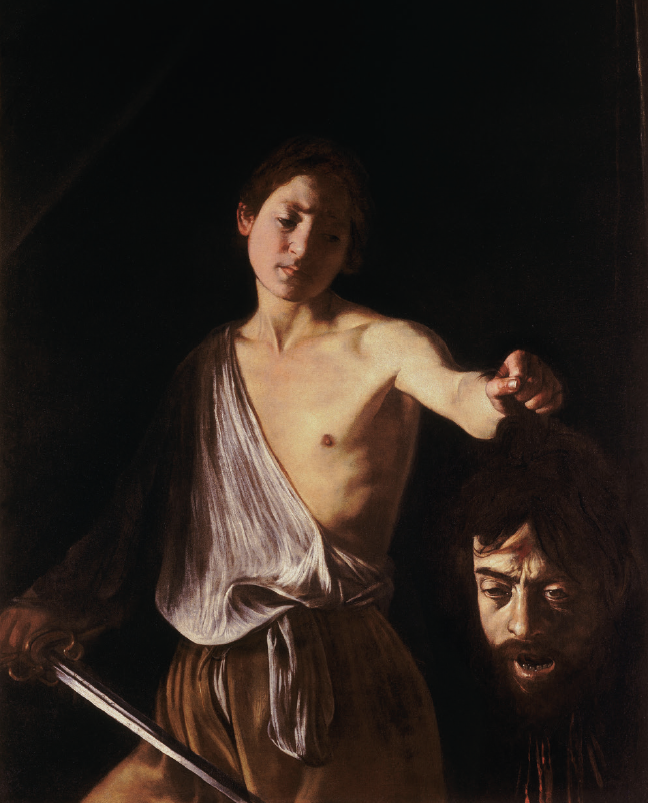
David with the Head of Goliath, 1609-1610
art4d: ถ้ามองข้ามเรื่องคุณภาพการพิมพ์ไป คิดว่า Caravaggio OPERA OMNIA ให้อะไรกับคนดูบ้าง
KT: ในความเห็นส่วนตัว เราคิดว่ามันน่าจะเป็นเรื่องสเกลขนาดเท่าจริง ขอเล่าประสบการณ์ส่วนตัวสักหน่อย เราชอบงานของ Edward Hopper แต่ส่วนใหญ่ก็จะดูเอาจากหนังสือแคตตาล็อกนิทรรศการหรือหนังสือรวมผลงานของเขาเอา จนมีวันหนึ่งได้ไปดู ภาพ Second Story Sunlight ของจริง ซึ่งตอนนั้นแหล่ะที่มันทำให้เราได้เข้าใจว่า medium มีผลกับความรู้สึกที่เรามีต่อภาพจริงๆ คือเราไม่ได้แค่ตะลึงกับความงามของงานจริงนะ แต่เราตะลึงกับสเกลจริง คือ ก่อนหน้านี้ที่เราคิดไปไม่ถึงว่า ไซส์จริงมันจะใหญ่เหมือนกับหน้าต่างขนาดใหญ่ของบ้านคน และยิ่งพอมันมาอยู่ในแสงสลัวของนิทรรศการด้วย มันทำให้เรารู้สึกเหมือนกำลังมองออกนอกบานหน้าต่างจากบ้านที่เรายืนอยู่ไปเห็นระเบียงบ้านหลังข้างหน้าที่อยู่ในภาพ นับจากนั้นมาเราเลยสนใจเรื่องเอฟเฟ็กต์ของ medium มากขึ้น และจากเอฟเฟ็กต์ตรงนั้นเราเลยคิดว่า เราน่าจะชินกับไซส์ของหนังสือแคตตาล็อกนิทรรศการและหนังสือภาพต่างๆ แล้วเราก็ไม่ได้คำนึงหรือคิดกับตัวเลขขนาด dimension ของภาพที่อยู่ตรงแคปชั่นภาพมากนัก ตอนที่เราดูในไซส์หนังสือ มันไม่ได้ให้อารมณ์เหมือนไปยืนมองบ้านคนอื่นแบบนี้ มันเปลี่ยนมุมมองและการตีความภาพนั้นในความคิดเราไปเลยนะ ดังนั้นเราคิดว่านอกจากเรื่องงานจริงแล้ว ไซส์งานจริงน่าจะมีผลกับมุมมองของคนดูพอสมควร คือในความที่มันเป็นขนาดจริง มันบรรจุไอเดียของภาพอีกชุดเอาไว้ด้วยที่หนังสือหรืออินเตอร์เน็ตให้คุณไม่ได้ ซึ่งตรงนี้เราให้ความสนใจกับบทบาทของตัวสื่อว่า มันเอื้อหรือเน้นให้เราได้เห็นมุมมองไหนมากกว่าด้วย แน่นอนว่าคุณภาพการพิมพ์เป็นเรื่องที่ต้องให้ความสำคัญ เพราะมันเป็นเรื่องละเอียดอ่อนมาก เราเห็นมาเยอะมากว่าแคตตาล็อกนิทรรศการศิลปะในยุโรปหลายต่อหลายเล่มพลาดเรื่องความเที่ยงตรงแม่นยำในเรื่องสี ในแบบที่คิวเรเตอร์เองก็ต้องนั่งปวดใจกันไป คือมันเป็นเรื่องยากมากในทางเทคนิคนะ คือถ้าจะคุมให้ได้เป๊ะมาก ราคาเล่มก็อาจพุ่งสูงจนกลายเป็นของให้คนกลุ่มเล็กๆ เก็บสะสม มากกว่าจะให้คนทั่วไปได้หามาอ่านติดบ้าน เรามองว่าการเปิดประเด็นรายละเอียดเหล่านี้จากคนที่รู้จักงานจริงก็เป็นเรื่องที่ดี เพราะนั่นหมายถึงว่า พวกเขาใส่ใจและช่างสังเกตในรายละเอียดต่างๆ แต่ความสัมพันธ์ระหว่างขนาดของมนุษย์ที่ไปยืนอยู่ตรงหน้าภาพ และไซส์ของภาพที่มันปะทะอยู่ตรงนั้น เราคิดว่ามันก็สำคัญ และมันก็น่าจะเป็นสิ่งที่นิทรรศการนี้ให้เราได้ ถ้าปริ้นท์ออกมาได้ในระดับคุณภาพที่ได้มาตรฐานมากกว่านี้

NP: มันต้องมองแยกเป็นคนละประเด็น texture งานจิตรกรรมก็ประเด็นหนึ่ง สเกลก็เป็นอีกเรื่องหนึ่งแต่เราขอ defend ให้ฝีแปรง แสงเงา ความหนา พื้นผิวเหล่านี้ เพราะแน่นอนว่ามันเป็นเรื่องสำคัญในการดูงานและศึกษางาน ถ้าได้เห็นงานจริงและรายละเอียดเหล่านี้ได้จริงๆ มันก็จะทำให้เห็นมิติงานศิลปะที่ครบถ้วนจริงๆ นะ แต่เราก็อยากจะบอกว่าภาพหนึ่งภาพมันมีความหมายและแง่มุมเยอะมาก ถ้าจัดแสดงด้วยสื่อแบบ reproduction แบบนี้ คุณจะมาเรียกร้องฝีแปรงไม่ได้อยู่แล้ว หมายถึงเราต้องตระหนักว่า สมมติมีคุณสมบัติ 10 อย่างที่จะทำให้ภาพๆ หนึ่งมันเป็นมาสเตอร์พีซ เราอาจจะได้ 5 หรือ 6 อย่างจาก reproduction คือเราไม่ควรคาดหวังว่างาน lightbox มันจะให้เราได้ทุกอย่าง เราควรเข้าใจข้อจำกัด และมองว่าเขาทำออกมาเพื่อการศึกษาใช่ไหม แล้วเจตนานี้มันประสบความสำเร็จขนาดไหน เราไม่ควรมองมันเป็น art object อย่างเดียวเพราะมันไม่ใช่ ผิดประเด็น
art4d: แล้วทำไมต้องจัดแสดงโดย lightbox คิดว่าสิ่งนี้คงเป็นคำถามที่หลายคนสงสัย เพราะแสงที่มาจากด้านหลังมันทำให้ contrast ของภาพหายไป โดยเฉพาะกับจิตรกรรมของ Caravaggio ที่เอฟเฟ็กต์ตรงนี้น่าจะเป็นส่วนสำคัญของงาน
NP: ถ้าให้เราสันนิษฐานในฐานะที่เคยทำงานคิวเรต เราคิดว่าตู้ไฟของ Rai มันทำให้ง่ายกับการจัดการ สมมติว่าถ้าส่งภาพไปพร้อมกับ lightbox เท่ากับว่าทางฝั่งคนรับงานไปจัดแสดงไม่ต้องคุมเรื่องการจัดแสงเลยนะ คือใช้แค่ห้องมืดๆ ก็สามารถเอางานไปวางได้เลย แต่ถ้าส่งเป็นแบบแคนวาสไป แล้วปริ้นท์ 3D แบบที่หลายๆ คนอยากให้ทำมันจะมีหลายปัญหาตามมา ไหนจะต้องคิดว่าจะส่องไฟจากทางไหน จะใช้ไฟอะไร จะต้องมี condition ยังไง เรามองว่ามันเป็นไปได้ยากมาก เพราะฉะนั้นคืออันนี้มันเป็นทางเลือกที่เหมาะที่สุดที่จะสามารถเอางานไปจัดแสดงได้ทุกสเปซ เราเห็นมาว่างานที่เมืองจีนสถานที่จัดแทบจะเป็นโกดัง มีบางส่วนที่เป็นเอาท์ดอร์ เราเริ่มรู้สึกว่านิทรรศการนี้มันคล้ายๆ กับเป็นโปรดักท์
KT: ในบริบทของอิตาลี ต้องบอกว่าเขามองสิ่งนี้เป็นอุตสาหกรรมนะ มันถือเป็น educational material สำหรับคนหมู่มากเลย ที่อาจดึงคนบางส่วนให้เข้าไปดูงานจริง ซึ่งก็หมายถึงจำนวนคนดูที่มากขึ้นให้กับอุตสาหกรรมวัฒนธรรมและการท่องเที่ยวของเขา เพราะมันเป็นสิ่งที่หล่อเลี้ยงให้ประเทศเขาอยู่ได้
NP: เราไปเจอมาเหมือนกันว่า Rai เป็น telecommunication cooperation เจ้าของเทคโนโลยีการสแกนนี้ ซึ่งเท่ากับว่า lightbox ที่ว่าเป็นสินค้าที่เขาขาย เราจึงมองว่ามันได้ประโยชน์ทั้งสองฝ่าย ทั้งฝ่ายที่ผลิตและทางฝั่งกระทรวงต่างประเทศของอิตาลี หรือองค์กรที่ทำงานเรื่องการเผยแพร่วัฒนธรรม เพราะเขาไม่ต้องลงทุนด้านการผลิต แต่สามารถนำงานพวกนี้ออกไปจัดแสดงได้ทั่วโลก
KT: แนวทางการใช้เทคโนโลยีในแบบนี้มันมีตั้งแต่ตอนที่วาติกันบูรณะ Sistine Chapel02 ตอนช่วงทศวรรษ 90 แล้ว ซึ่งเป็นการร่วมมือกันระหว่างทางวาติกันกับสถานีโทรทัศน์ของญี่ปุ่น Nippon Television Network Corporation ที่เข้ามาสนับสนุนการบูรณะภาพจิตรกรรมฝาผนังที่เป็นผลงานของ Michelangelo ซึ่งเขาถ่ายเก็บทั้งภาพนิ่งและภาพเคลื่อนไหวมันเป็นข้อมูลที่มีความละเอียดที่สูงมาก และใช้เป็นงานอ้างอิงสำหรับการซ่อมแซมงานต่อไปในอนาคต ข้อแลกเปลี่ยนสำหรับโปรเจ็คต์นั้นก็คือ ทางสถานีโทรทัศน์ของญี่ปุ่นได้ลิขสิทธิ์ของสารคดีและภาพที่บันทึกไว้ในระหว่างการบูรณะไปเผยแพร่ เราก็เคยเห็นคอลเลคชั่นหนังสือชุดนั้นมันเก็บขั้นตอนและรายละเอียดไว้ดีมาก อีกอย่างที่ต้องไม่ลืมก็คือการทำพวกดิจิตอลไฟล์เอกสารทางประวัติศาสตร์สำคัญๆ อย่างเช่น CENSUS03 ฐานข้อมูลใหญ่ของการศึกษาเอกสารหรือชิ้นงานศิลปะยุคเรอเนซองส์ (The Census of Antique Works of Art and Architecture Known in the Renaissance) มันก็เริ่มกระบวนการเข้าสู่ระบบดิจิตอลในช่วงยุค 80 เป็นโปรเจ็คต์เกือบ 40 ปี จำได้ว่าตอนที่เราไปเริ่มเรียนที่อิตาลีตอนปี 2008 อาจารย์ที่นั่นเล่าว่าโปรเจ็คต์นี้เริ่มมาได้เกือบ 30 ปีแล้ว ซึ่งเขาพยายามทำให้คนทั้งโลกสามารถเข้าถึงตัวเอกสารที่แต่เดิมมันเข้าถึงยากมากๆ และเป็นแหล่งข้อมูลสำหรับคนทำงานด้านวิชาการที่เป็นผู้เชี่ยวชาญเฉพาะเท่านั้น ซึ่งการจัดระบบข้อมูลที่ดีและการเปิดกว้างต่อการเข้าถึง ก็คือการสนับสนุนการทำงานด้านนี้เลย เพราะมันทำให้คนคิดและวิเคราะห์เรื่องนี้ได้คล่องตัวมากขึ้น เรามองว่าไอเดียของโปรเจ็คต์นี้มันเน้นการเป็นสื่อการเรียนรู้นะ แลัวมันก็จะสอดคล้องกับกระแสในภาพรวมตอนนั้น ที่เทคโนโลยีดิจิตอลกำลังเริ่มใช้งานกันได้อย่างแพร่หลายมากขึ้นเรื่อยๆ ที่เราจำได้ก็คือการเกิดขึ้นของ digital archive เป็นจำนวนมากในบริบทประวัติศาสตร์ศิลป์ของอิตาลีโดยเฉพาะความเฟื่องฟูช่วงหลังปี 2000 เป็นต้นมา
NP: เพราะว่าอินเตอร์เน็ตก็เพิ่งจะมาตอนยุค 2000 เหมือนกัน น่าจะเป็นกระแสทั้งหมดในช่วงนั้น
KT: ใช่ แต่เข้าใจว่าช่วงสองสามทศวรรษแรกที่พัฒนา ฐานข้อมูลมันอาจจะถูกใช้แค่ในวงวิชาการในห้องสมุด แล้วต่อมาพอมันได้จังหวะกับช่วงที่เทคโนโลยีมีราคาถูกลง คนเข้าถึงได้ง่ายขึ้น เขาเลยเผยแพร่มันได้ในวงกว้างขึ้น แต่ในภาพรวมเราคิดว่าแนวโน้มของการให้ความสำคัญของสื่อมันน่าจะเริ่มมาตั้งแต่ต้นปี 80 แล้ว การใช้สื่อในการมองความเป็นไปได้หรือข้อสันนิษฐาน อย่างโปรเจ็คต์ของพวก Leonardo da Vinci คือการใช้สื่อมาค้นหาความเป็นไปได้ต่างๆ นานาของคอนเซ็ปต์ประดิษฐกรรม หรือเครื่องมือบางอย่างของศิลปินที่ลำพังคนเห็นแต่ดรอว์อิ้งอาจจะนึกไปไม่ถึง หรือจินตนาการตามได้ยาก เขาก็ช่วย visualize มันขึ้นมาให้จากแบบต้นฉบับ ตัวอย่างเช่นหลายๆ โปรเจ็คต์ของ Martin Kemp นักประวัติศาสตร์ศิลปะ
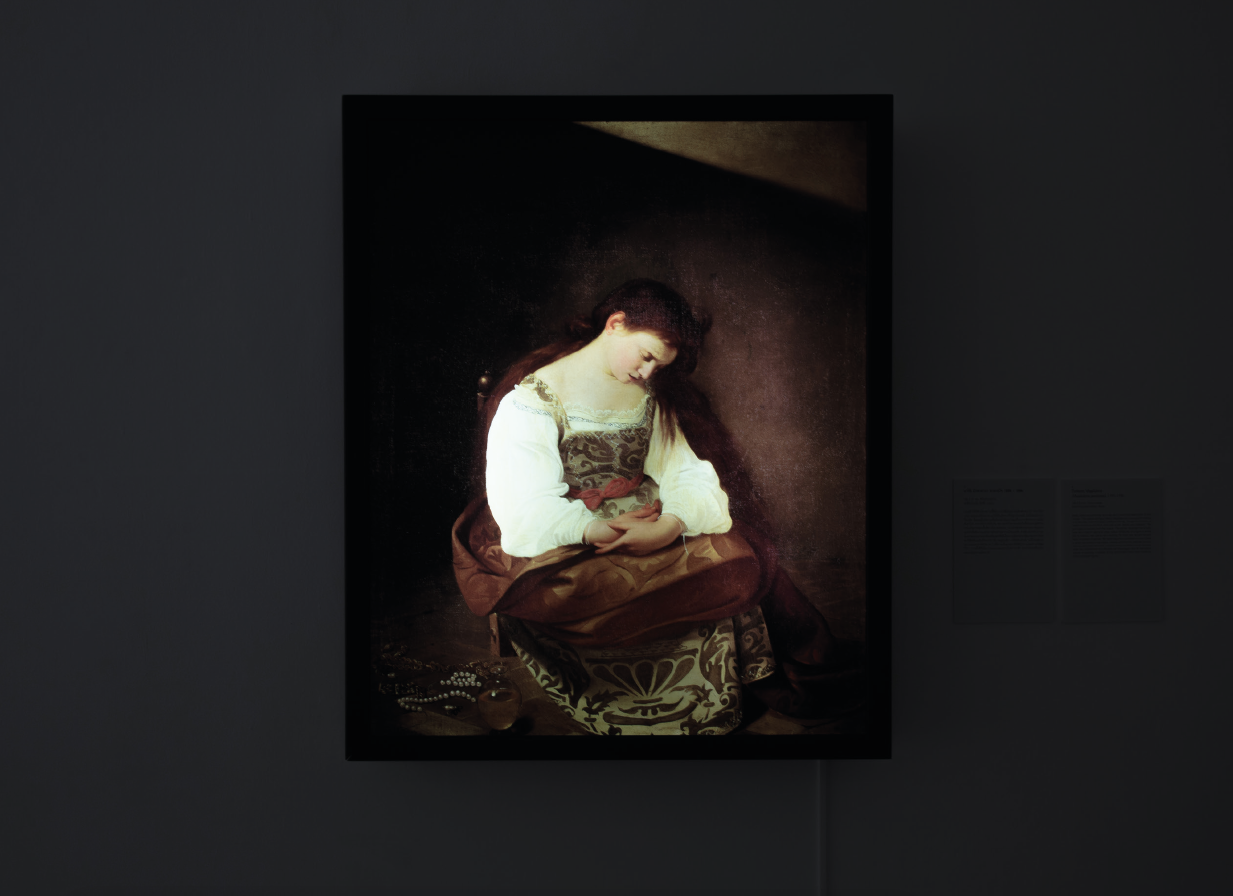
เราต้องไม่ลืมว่าอิตาลีเป็นประเทศด้านอุตสาหกรรมใหญ่เป็นอันดับสามของยุโรปตะวันตก แต่เขาจะเป็น OEM ของประเทศที่มีอุตสาหกรรมใหญ่กว่านั้น คือเยอรมนีกับฝรั่งเศส แล้วที่เราบอกว่ามันเป็น educational material คือต้องเข้าใจบริบทก่อนว่า มันมีตลาดคนดูของพวกนี้ประมาณหนึ่ง นักเรียนมัธยมปลายสายคลาสสิคในอิตาลีมีวิชาประวัติศาสตร์ศิลป์เป็นวิชาหลัก คือเหมือนเรียนเลข เป็นหน่วยกิตใหญ่ของหลักสูตร เพราะฉะนั้นเราเข้าใจว่า Rai ทำตัวนี้ออกมา มันก็ขายในประเทศตัวเองได้อยู่แล้วส่วนหนึ่งเลย เพราะว่าที่นั่นจะมีวัฒนธรรมของการผลิต04 คล้ายๆ กับคอลเล็คชั่นที่แถมมาหรือขายคู่มาในราคาไม่แพงกับหนังสือพิมพ์ หรือทำเป็น cultural series ที่ลงลึกในแต่ละประเด็นหรือสาขาวิชาเลยนะ เขามีทั้งหมวดสถาปัตยกรรม ศิลปะ และมีแยกเป็นยุคต่างๆ เรอเนสซองส์ บาโรค แล้วก็ตีพิมพ์รันเวียนไปแบบนี้ทั้งปี ซึ่งคนที่ลงทุนทำของพวกนี้ในอิตาลีเองก็อยากพยายามส่งออกสิ่งนี้เหมือนกัน เพราะถ้าทำได้มันก็ได้ตลาดเพิ่ม เราคิดว่า นอกจากอุตสาหกรรมหนักที่เขามีการส่งออกชัดเจน เขามีสินค้าส่งออกอย่าง แฟชั่น อาหาร กับสิ่งนี้แหละ ซึ่งถ้าเป็นสถาปัตยกรรมอย่าง Colosseum หรือ Pantheon มันเคลื่อนย้ายไม่ได้ไง จะถ่ายรูปและเอามาทำสเกลจริงเต็มๆ ก็ทำไม่ได้ นอกจากทำโฮโลแกรมบางส่วนให้คนเข้าไปเดินดูได้ เราคิดว่าอย่างเดียวที่เป็นไปได้คงจะมีแค่สิ่งนี้แหละ ซึ่งมันก็ต้องมาในเสื้อคลุม educational material แต่ความจริงบทบาทมันก็เป็นแค่ตัวเปิดหรือ appetizer ไว้เรียกน้ำย่อยให้คนที่ชอบสนใจตามไปดูของจริงต่อเท่านั้น
art4d: ถ้าเรามองว่ามันเป็นสินค้า ทำไมสินค้าเหล่านี้ต้องถูกนำมาจัดแสดงในฟอร์แมตนิทรรศการ ที่ต้องมีชื่อนิทรรศการ มีชื่อ guest curator มีพิธีเปิดนิทรรศการ
KT: อย่างที่มีสื่อหัวหนึ่งเสนอให้เอาขึ้นบิลบอร์ด คือเราไม่มีปัญหากับกรณีนี้ แต่ถ้าถามว่าทำไมจะต้องเอามาจัดในหอศิลป์ เราคิดว่ามันเป็นเรื่องการเมืองด้านวัฒนธรรมโดยตรงเลย เพราะมัน “สง่างาม” กว่าอยู่แล้ว นี่เป็นงานฉลองความสัมพันธ์มันไม่สามารถเอามาฉลองโดยการแปะบนบิลบอร์ด เว้นแต่จะมีศิลปินคนหนึ่งที่มารับหน้าว่า “ฉันจะเอางาน Caravaggio ไปวางบนบิลบอร์ดบางนาตราด” แต่ว่าในกรณีนี้ สำหรับเรามันเป็นความสำเร็จรูปที่ต้องการแค่สเปซที่อยู่ในสถาบันบางอย่าง ซึ่งการจัดเซ็ตมาแบบนี้ มันก็ลงตัวในแง่การจัดการกับทุกฝ่าย อันนี้คือถ้ามองกันแบบตรงๆ แต่ถ้าจากที่เราอ่านคร่าวๆ ของงานในปี 2003 คือมันมีประเด็นเรื่องของปัญหาความเปราะบางของตัวชิ้นงาน ที่มีความเก่าและถูกขอยืมคอลเล็คชั่นบ่อยมาก มันมี request เยอะมาก การจัดเซ็ตแบบนี้ขึ้นมาก็น่าจะเป็นวิธีหนึ่งในการบริหาร request ที่เข้ามาด้วยเพราะเป็นการตัดขั้นตอนบางอย่าง คือเขาแค่จัด visual set ไปแล้วทางนั้นก็ไปบริหารกันเอาเอง ซึ่งผลที่อาจจะตามมาก็คือจะมีคนพยายามมาดูงานจริง และมันก็จะได้ผลลัพธ์ทางเศรษฐกิจกลับมา เช่นเดียวกับในอิตาลี คือนิทรรศการแรกๆ มันจัดในอิตาลี คือก็เข้าใจว่ามันก็จัดให้คนที่ไม่ได้อยู่ในโรม เนเปิลส์ ฟลอเรนซ์ มิลาน คนที่ไม่ได้อยู่ในสี่เมืองที่ว่าได้มีโอกาสเข้าถึงงานเหล่านี้ได้ผ่านตัวงานที่เป็นการผลิตซ้ำงานจริงขึ้นมาเช่นกัน
NP: ก็คงจะต้องต่อยอดจากที่เราพูดถึงความสำเร็จรูปไปก่อนหน้า ถ้าถามว่าทำไมต้องเป็นนิทรรศการก็ตอบได้ว่าเพราะมันง่ายที่สุดไง คือจะเอาไปไว้บนบิลบอร์ด เอาตู้ไฟใหญ่มากไปตั้งบนนั้นมันยากมาก มันต้องดีลกับคนเยอะ อีกอย่างแต่ละประเทศวิสัยทัศน์ก็ไม่เหมือนกัน อย่างที่เราเล่าว่าเมืองจีนเขาเอางานไปจัดในโกดัง หรือพื้นที่เอาท์ดอร์แบบนั้น เพราะว่าเขามี taboo กับศิลปะน้อยกว่าเรา เขาคุ้นชินกับขนบของศิลปะร่วมสมัยมากกว่า เขาไม่ได้มองศิลปะเป็นอะไรที่แข็งๆ ว่าต้องเป็นแบบนี้แบบนั้นเท่านั้น เราคิดว่าถ้าไปจัดในประเทศที่มีลูกเล่นได้ หรือมีสเปซที่หลากหลายกว่ามันจะน่าสนใจมากกว่านี้ คือเรามองว่ามันอยู่ที่พื้นฐานความรู้ในเรื่องศิลปะร่วมสมัยของแต่ละประเทศ เรารู้สึกว่าประเทศไทยมีข้อจำกัดตรงนี้ เช่นเดียวกันกับประเทศในภูมิภาคนี้ คือเราจะไปคาดหวังอะไรที่มันมากเกินไปกับประเทศตัวเองมันก็ยาก
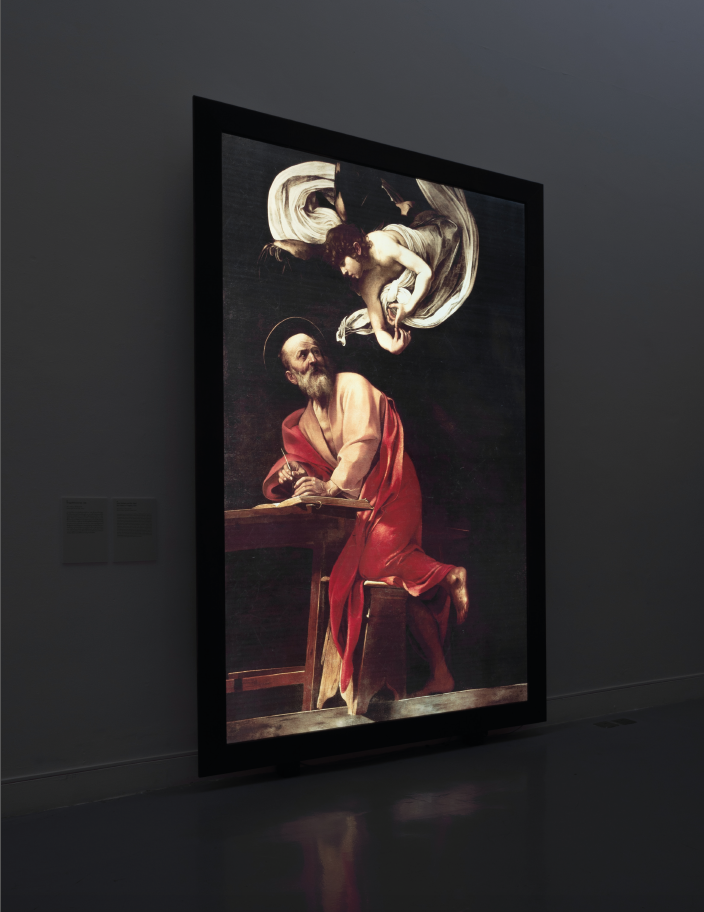
art4d: เท่ากับว่าความขาดของนิทรรศการนี้คือมันแทบจะไม่ได้อธิบายตัวมันเองเลย? พอจะมีข้อเสนอแนะที่คิดว่าน่าจะเป็นประโยชน์ต่อการจัดแสดงในครั้งต่อไปไหมครับ
KT: อันนี้เห็นด้วย เพราะว่าเราคิดว่านิทรรศการนี้มันชัดเจนมากว่าเป็นเหมือนโปรดักท์ใส่กล่องมาจัดแสดงมันจะดีกว่านี้ถ้ามันจะตอบคนดูได้ในตัวงานนิทรรศการว่า อะไรคือสาเหตุของความริ้วเหล่านั้น คือตอนเราดูเสร็จเราเกิดคำถามว่ามันเกิดอะไรขึ้นกับภาพที่พิมพ์ออกมา มันเป็นปัญหาของข้อจำกัดทางเทคนิคการสแกนภาพจริงในสถานที่จริง อย่างในผนังโบสถ์ ที่มีระยะจำกัดหรือเปล่า แบบไฟล์ต้นฉบับมีปัญหาเลยได้แค่นี้ หรือพิมพ์พลาด หรือการขนส่งภาพที่พิมพ์ออกมาทำให้เกิดความเสียหายแบบสุดวิสัย คืออย่างน้อยๆ มันก็ให้ความชอบธรรมกับตัวงานด้วยในทางหนึ่ง
NP: เท่าที่เราดู สภาพของรูปขนาดเล็กยังโอเคอยู่ แต่รูปขนาดใหญ่คุณภาพแย่มาก เห็นชัดเจนว่าเป็นรอยลายทาง มีรอยยับ เราไม่แน่ใจว่าความเสื่อมที่เกิดขึ้นมันเป็นเพราะข้อจำกัดทางเทคโนโลยีหรือเกิดจากการใช้งานหลายๆ ที่ คือถ้าจะบอกว่าไปโชว์ครั้งแรกก็เป็นรอยขนาดนี้แล้วก็แสดงว่ามันเป็นเรื่องเทคโนโลยี แต่ว่าถ้าเป็นเพราะถูกนำไปจัดแสดงหลายๆ ครั้ง จึงทำให้เกิดความเสื่อมมันก็ปริ้นท์ใหม่ได้ไม่ใช่หรือ หรือกลับมาพูดในประเด็นการแสดง texture ของภาพ มันก็สามารถแสดงผ่านภาพงานพิมพ์ 3D ให้ดูว่าของจริงมันเป็นอย่างไรก็ได้ หรือถ้ามีเงินเยอะหน่อยก็ทำมุมหนึ่งขึ้นมา จำลองบรรยากาศโบสถ์ให้มีกิมมิคแบบหยอดเหรียญแล้วไฟสว่างขึ้นสามสิบวินาทีเหมือนแบบในโบสถ์บาโรคจริงเลยก็ได้ และก็ควรมีห้องสุดท้ายก่อนจบนิทรรศการให้มีหนังสือและแคตตาล็อคเกี่ยวกับงานของศิลปินและของยุคสมัยของเขาให้คนได้เข้ามานั่งอ่านได้ แล้วก็อาจจะมีเวิร์คช็อปสำหรับเด็กนักเรียนนักศึกษาเพิ่มขึ้นกว่าที่ตอนนี้มีแค่เล็คเชอร์ หรือจะจัดโปรแกรมหนังทั้งที่เป็นสารคดีและภาพยนตร์เกี่ยวกับ Caravaggio ด้วยก็ได้ คือมันจะเป็นโชว์ที่ดีกว่านี้ได้ แต่กลับไม่มีใครพูดตรงนี้เลย เราคิดว่าการวิพากษ์วิจารณ์ควรเป็นเรื่องการนำเสนอทางออกด้วย ไม่ใช่แค่โจมตีกันไปมาอย่างเดียว แต่แน่นอนตอนนี้ BACC อยู่ในช่วงเปลี่ยนผ่าน เราคาดหวังกับ BACC ได้มากกว่านี้ไหม อันนี้ไม่แน่ใจ
KT: คือเราไม่จำเป็นต้องรอผู้เชี่ยวชาญจากอิตาลีมาเล่าเรื่อง Caravaggio ก็ได้นะ อย่างการจัดทอล์คที่ผ่านมาเนี่ย แต่ว่าทำให้เป็นการสัมภาษณ์ผู้เชี่ยวชาญหลายๆ คนในไทยแล้ว record ให้เป็นลูปวิดีโอรันไปเรื่อยๆ ให้คนดูในไทยได้เข้าใจพาร์ทต่างๆ เหล่านี้มากขึ้นกว่าเดิม ทั้งกระบวนการอนุรักษ์งานจิตรกรรม ไปจนถึงการทำความเข้าใจกับงาน reproduction ผ่านนิทรรศการครั้งนี้ และเราคิดว่าประโยคจาก Tristram Hunt ผู้อำนวยการพิพิธภัณฑ์ Victoria & Albert ที่กล่าวว่า “เทคโนโลยีกำลังเปลี่ยนแปลงวิธีที่คนดูเข้าถึงและมีปฏิสัมพันธ์กับวัตถุและคอลเล็คชั่น” น่าจะสรุปบทสนทนาของเราได้ดี

Cultural exchange between Thailand and Italy has been consistent and diverse. The relationship between the two countries dates back to the reign of King Rama 6 when Siam participated with its pavilion in the 1911 Turin International Expo, which later inspired the idea of organizing a similar kind of event at Saladaeng field (today’s Lumphini Park). A more up to date memory is the participation of Thailand in the previous Venice Biennale where the Thai Government showcased its national identity with KRUNG THEP BANGKOK (by Somboon Hormtientong) or back in 2009 with the travel-agency inspired pavilion, Gondola al Paradiso Co., Ltd., being set up to invite people to visit Thailand. For 2018, the floating market, Muay Thai and Thai massage made their way to Pescheria di Rialto as a part of the opening of the Venice Biennale of Architecture while the Italian government brought their Italian showcase to Thailand to celebrate the 150th Anniversary of diplomatic relations between the two countries with the exhibition ‘Caravaggio OPERA OMNIA’ held at Bangkok Art and Culture Centre, in May of 2018.
To see such so-called Thainess represent the country at an international art platform with a floating market or through Muay Thai superficially and stereotypically depicts the country’s characteristics as something one might expect, but what’s really surprising is Caravaggio OPERA OMNIA and the controversy that followed. It ignited heated criticism among people from the art community over the printing quality of the exhibited pieces and particularly the use of a lightbox to display the printed editions of Caravaggio’s paintings, which was said to fail miserably in capturing the artist’s legendary brushstrokes. And while there was a group of people who pointed out the upsides of the exhibition acting as a great learning medium for art history education in Thailand, the argument intensified to the point where even ‘Team Brushstroke’ and ‘Team Lightbox’ were established.
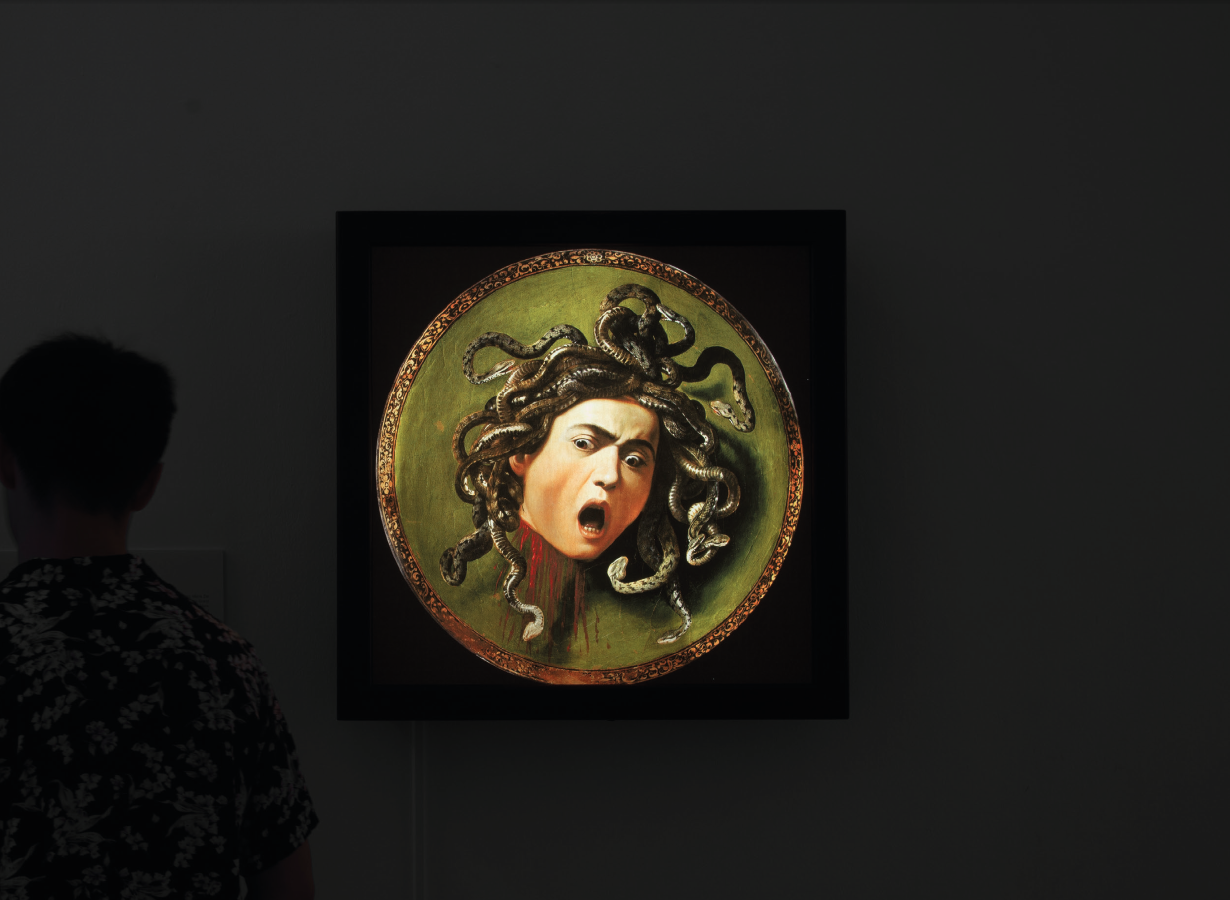
The situation escalated when an online media outlet attacked the lightbox exhibition by organizing a parallel exhibition and even going the extra mile by having Vincent van Gogh’s paintings printed for spectators to compare the printing quality with their own eyes. An announcement was later released stating that, three days after the final date of the exhibition, the HD printed pieces would be given to the BACC and the Italian Embassy.
Amidst the controversy and hate speeches that are being thrown around, art4d invited Narawan Pathomvat who is the founder of contemporary art library ‘The Reading Room’, and former adjunct lecturer at Department of Art History, Faculty of Archaeology, Silpakorn University and Kanokwan Trakulyingcharoen, a contemporary architectural historian of the Institute for Architectural Theory, History and Heritage Preservation, Faculty of Architecture, University of Innsbruck and a veteran academic with over ten years of experience and a great acquaintance to Italian culture, to debate over the phenomenon and other issues surrounding the Caravaggio OPERA OMNIA exhibition.
* The conversation occured on 10th May 2018
art4d: What are your thoughts on the criticisms that the exhibition has been receiving, particularly the issue of not having the original pieces shown at the exhibition?
Narawan Pathomvat: I understand that it’s an opinion, and particularly the artists or practitioners consider the originality of an art piece to be a crucial factor, which is understandable. Original works are special, one of a kind, and they have this aura that cannot be found in a reproduction. Of course I agree that having the original paintings would definitely be better than having the reproductions but, in this case, it was impossible for that to happen. If we were going to make any criticisms about the exhibition per se, they would have to be in relation to other factors and not about not being able to have the original paintings. That argument could be endless. As a student and teacher of art history, I see the virtues of reproductions. Many of the works I have come to know and learn from in textbooks are the reproductions of the original works that were lost. We learn about Greek art from the copies made in the Roman Era or even in the pre-print media period, paintings were copied on all kinds of mediums from utensils like plates and bowls to carpets. These objects are sent off to other parts of the world and works of famous artists were introduced through these diverse forms of reproduction. It’s a very common process in the context of art history.
Kanokwan Trakulyingcharoen: I don’t understand why some people asked why the exhibition bothered to have the lightboxes because they’re a part of the program designed by the Italian curatorial team. Besides, I don’t understand why they detest lightboxes so much anyway. As a medium, there is nothing wrong with lightboxes in my opinion, but if you want to discuss or criticize the quality of the reproductions or the colors that are deviated by the lighting, that’s understandable.
NP: I think it’s because they’re disappointed that they aren’t the original works and the quality of the reproductions isn’t up to standard. I personally don’t like the lightboxes but I do try to appreciate what the exhibition has to offer. But as the debate continues, it turns out that you’re forced to take sides, just like everything that happens in this society. Either you’re pro-brushstroke or you have to be pro-lightbox, and that doesn’t contribute anything substantial to the debate. And it’s a shame because a lot of people from the art industry don’t want to see the show because of that. But I think the people who are not really in the art community appreciate this exhibition more, partly because it’s intended to attract the interests of people with a certain level of interest in art and culture.
KT: Yes. I agree that this exhibition is for people who are not exactly art buffs but my interest lies in the questioning of after all that is done, are there any possible issues we can discuss? In a way, I think when the exhibited works are not original, it creates this casual vibe and people don’t feel intimidated because the works don’t have that aura that would create this overwhelming impact, especially for those who have never seen the real works. It’s the kind of exhibition that doesn’t need that much of a protocol.

Boy with a Basket of Fruit, 1593-1594
You don’t have to have any background knowledge of the works and you can still enjoy the exhibition because that is what it intends to do. It doesn’t need to have tight security like it would if it were to show the original works and that allows for people to interact with and engage with the works better. What I’m trying to say is, reproductions have their own contributions that they make to the public, because we’re in a country where this type of art has been made very distant from our perception and knowledge. In Europe, whether it’s Italy or Austria, there’s a concept that education is a right and I believe that an exhibition of such nature is about the ‘right to learn.’01 In other words, it’s a learning medium that allows for people in the society to know and understand more about art.
NP: This exhibition is more casual and welcoming than most contemporary art exhibitions. Personally, I look at it as someone who works in education, and I was a little surprised to see that professors of art and art history didn’t even try to point out the useful aspects that can be further elaborated upon, but instead, what they dis, criticize and attack are things that are impossible to do like bringing the original works to the show. Some of the comments are so harsh that I thought BACC was some world-class museum while the truth of the matter is that BACC is not even a museum. It’s an art center. It doesn’t have its own permanent collection or the systems that a standardized museum is required to have such as temperature control. If we were going to criticize the exhibition, there are so many more interesting aspects to talk about from its lack of educational materials, I mean, there are a lot more possibilities in terms of how this exhibition could be organized and it has the potential to become a better show.
art4d: If we were to look past the printing quality, what do you think Caravaggio OPERA OMNIA has given to the viewers?
KT: From my personal point of view, it’s the physical scale that is the same size as the originals. If you don’t mind, I want to tell you about my own personal experience. I’ve always liked Edward Hopper’s works and most of the time, I see them in exhibition catalogues and the retrospective books of his works. But one day I finally had the chance to see the original ‘Second Story Sunlight’ painting and that was when I realized how the medium can affect our feelings and emotions towards a painting. I mean, I was blown away, not only by the aesthetic elements of the work but also the scale. Before, I had never imagined that the painting would be the same size as a large opening of a person’s house. Especially when it was shown under the dimly lit exhibition space, I remember feeling like I was looking out the window of a house and saw the porch in the painting before my eyes. I’ve become more interested in the effects of medium ever since. And from that experience, I think that we might be used to the size of a painting we see in catalogues and books.
We didn’t think much about size and the dimension of a painting provided in the description. When we look at a painting in a book, it will never create the kind of experience that makes you feel like you’re actually looking out of someone’s actual house. It changed the way I looked at and interpreted that painting entirely. So apart from the originality, the actual size of a work does have a great deal of impact on viewers’ perceptions. The fact that these paintings are reproduced to be in the actual size with the original, it contains another set of ideas of another painting that no books or the Internet is able to provide. Surely, the printing quality is something that needs to be seriously considered. I’ve seen catalogues of art exhibitions in Europe make mistakes in the precision of colors because that’s a very sensitive element of paintings. That’s the kind of mistake that curators have to suffer. I mean, it’s incredibly hard, in terms of techniques, to control the colors to be very precise, not to mention the cost of the book that could escalate to the point where it could only be accessed by a specific group of people or collectors and leave no chance for ordinary people to buy and own them. To have these issues opened up for discussion among the people who really know the works is a good thing because it means that they are very attentive and observant of the little details. But the relationship between the human scale and the actual physical size of a painting, including the way it confronts us, that’s equally important and that is what this exhibition would have been able to deliver if the printing quality were better.
NP: It’s a different issue. The texture of a painting is one thing and the scale is another thing. But I would have to defend the brushstrokes, shadow, and details of the texture. Certainly, these elements and details are important when you study these paintings because they allow for you to see and comprehend a work in such comprehensive dimensions. But I would also like to say that a painting can contain so many aspects and meanings, and if you’re going to organize an exhibition using reproductions, you can’t really demand to see all the details of the brushstrokes. I mean you have to realize that, let’s say, there were 10 different elements that would make a painting a masterpiece, we might get 5 to 6 elements from a reproduction. I don’t think we should expect that a lightbox would be able to give us everything we want to see. We should understand the limitations and look at the intention they have for the exhibition, which is the educational purpose. You have to think about whether the intention is achieved. You don’t look at it solely as an art object because it isn’t. That’s a different issue.
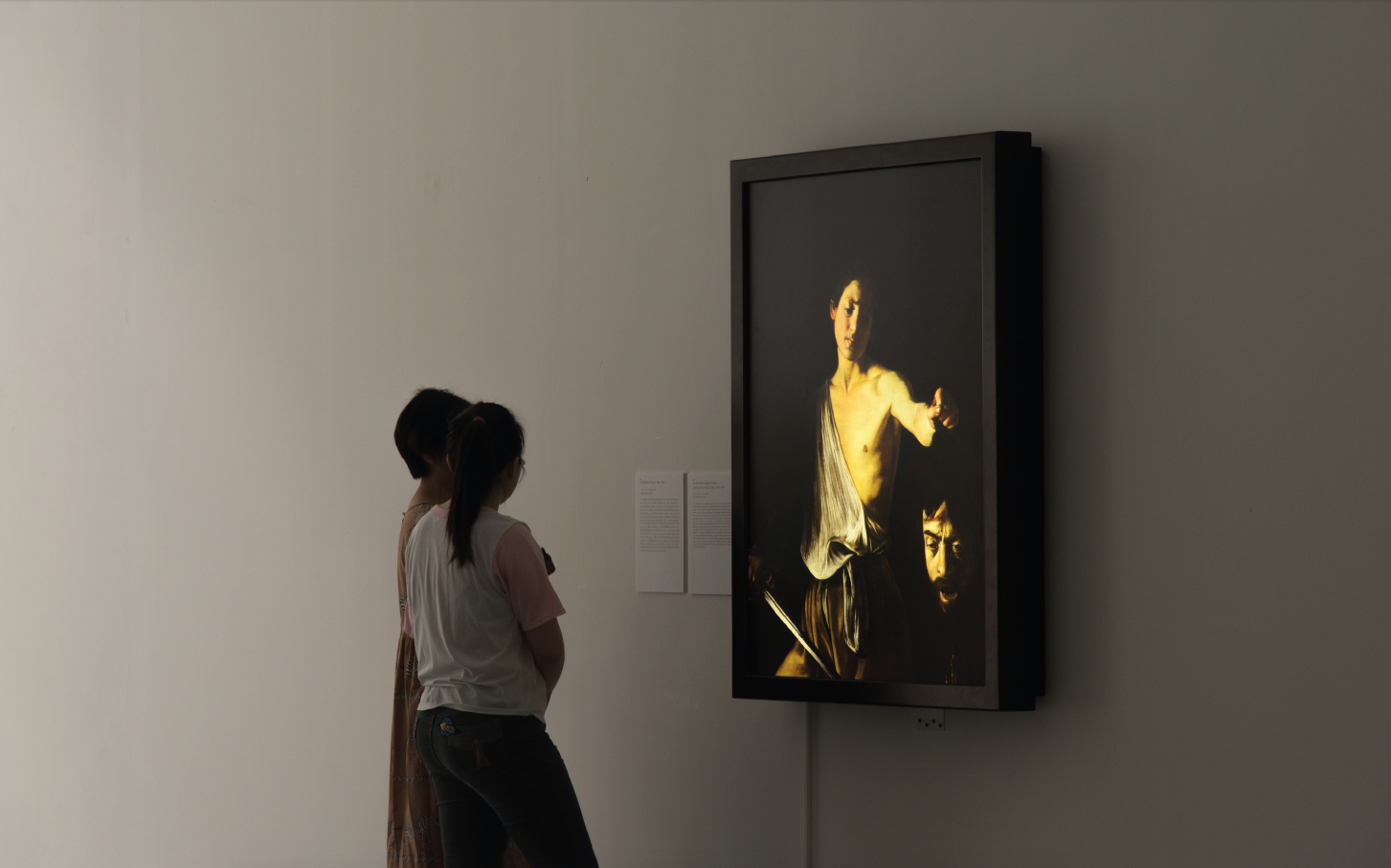
art4d: Then why use lightboxes? That’s the question everybody is asking because the light emitting from the boxes eliminates the contrast of the paintings especially with Caravaggio’s works, in which these effects are the key elements.
NP: From my assumption as someone who used to curate exhibitions, I think Rai’s lightboxes make it easier to manage the show. For example, if the paintings are shipped with the lightboxes, that means the people waiting at the other end don’t have to handle the lighting at all because what the works need is a dark exhibition room and that’s it. But if you shipped canvases to do the 3D printing, which is a method that many propose, there would be many more problems that would follow. You have to work out the direction of the lighting, the type of light bulbs you can use and several other conditions that are involved. It’s almost impossible for things to be organized that way so this is probably the most suitable option to exhibit the works because it can be done in practically all types of spaces. The one in China was held in a space that looked almost like a warehouse and there was even an outdoor space. I begin to feel that this exhibition is some sort of product in a way.
KT: In Italy’s context, they see it as an industry. It’s considered an educational material for the masses with the potential to attract a number of people to see the show, which means a bigger number of tourists for the country’s cultural and tourism industry because these things are the veins that keep Italy’s economy alive.
NP: I looked it up and found that Rai is a telecommunication cooperation that owns this scanning technology, which means that these lightboxes are among the products that they sell. It’s a win-win situation for both sides, whether it’s the manufacturer or Italy’s Ministry of Foreign Affairs including the organizations that are behind the country’s cultural promotion because they don’t have to invest in the manufacturing process and they are able to take these works and organize exhibitions worldwide.
KT: This approach to technological utilization has been around since The Vatican’s renovation of the Sistine Chapel02 back in the 1990s, which was a collaboration between The Vatican and Nippon Television Network Corporation who helped support the renovation of Michelangelo’s mural painting. The original painting was photographed and recorded as moving images, and it’s data of an extremely high resolution that is used as a reference for future restoration. The exchange for that support is that the television network was given the copyright to distribute a documentary about the restoration. I used to see that collection of publications and it documents the entire process in such great detail. Another thing we cannot forget is the creation of digital files of important historical documents such as CENSUS03 (The Census of Antique Works of Art and Architecture Known in the Renaissance), which entered the digitalization process in the 1980s. It’s a 40-year-long project. I remember when I first began my studies in Italy in 2008 and a professor of mine said that the project had been going on for 30 years and he was trying to create access to these documents, which were once extremely difficult to obtain, in order for them to serve as a resource for academics and specialized experts. Efficient data management and accessibility are the means of support for people who work in this particular field of study because it enables people to develop ideas and propose analyses more easily. I think the concept behind the project is for it to primarily serve as an educational medium, which resonates with the overall trend at the time when the digital technology was beginning to be widely used. I remember the births of a large number of digital archives within the context of Italy’s art history, especially the post-2000 digital boom.
NP: The Internet began to flourish in the beginning of the 2000s, too, so it was the big trend of that particular period.
KT: Exactly. But during the first few decades of the development, the database was used exclusively by members of academia and libraries, and it happened to be the time when technology became more affordable and accessible, allowing for the information to be published and reach a wider audience. But in the big picture, we think the tendency to use media as a tool began in the early 80s. Media has been used to help conceive new possibilities and hypotheses such as the projects related to Leonardo da Vinci’s works, in which it is used to search for different possibilities of concepts, inventions and tools that the artist created, because seeing his drawings alone might not be enough for people to imagine how these creations were materialized. The media helps to visualize that using these original drawings; for example, with several projects of art historian, Martin Kemp.

We mustn’t forget that Italy is the third largest industrial country in Western Europe but they manufacture primarily OEM products for bigger industrial countries like Germany and France. And when I said that it’s an educational material, we have to understand the context first and that there’s a market for this kind of audience. High school students in Italy study art history as compulsory subjects. It’s mandatory like math. These subjects count for a lot of credits in the curriculum so if we can understand that, Rai manufactures this product and it is already sold in its own country.04 There is this culture, in which a collection of publications are printed as a supplement of a newspaper or a cultural series that provides in-depth details regarding different issues and fields of study. There is architecture and art and these are broken down into different eras such as the Renaissance, Baroque, etc. and they would publish these publications in a cycle within an entire year. The people who invest in these products are trying to export them because it means the market can be expanded. I think in addition to the export of products from the heavy industry, the country also exports fashion and food and there’s this thing – if it were architecture like the Colosseum or the Pantheon, you couldn’t really move these things and you couldn’t take pictures and recreate them in a life-sized scale. What you can do is create a partial hologram for people to experience the space. I think that’s the only viable option. And all these things are cloaked educational materials. But the role of the Caravaggio exhibition is to serve as an appetizer for the people who may be interested enough to go see the real thing.
art4d: If we were to look at these reproductions as merchandise, then why are they presented in the format of an art exhibition with a title, a guest curator and even an opening?
KT: It’s like how a media outlet proposed the idea of promoting the show by putting an ad on a billboard. I don’t have a problem with that. But to the question of why it has to take place in an art gallery, I think it has a direct connection with the aspect of cultural politics because there’s this integrity of the celebration of the diplomatic relationship between the two countries and it cannot be celebrated through an advertisement on a billboard unless there were an artist who would step up and say, ‘I want to put a Caravaggio painting on a billboard on Bangna-Trad Road’ or something. But in this particular case, to me, it’s the ready-made convenience of using a space that belongs to some sort of institution. And this ready-made scenario offers the convenience of management for everyone involved. This is the case if we were to look at it straightforwardly. But from what I read roughly about the 2003’s exhibition, there was this issue about the fragility of the works, which are very old and the collection has been borrowed relentlessly. So due to these requests, this system has been set up so it could be one of the ways to manage the submitted requests because it helps to eliminate certain steps in the process. I mean all they have to do is set up the visual set and leave the rest to be executed by the team at the receiving end. What follows is the possibility that people who see the exhibition will want to see the original works and that’s the economic return for the country. It’s the same thing with Italy. The exhibition was first held in Italy for people who do not live in Rome, Naples, Florence or Milan to have access to these great artistic creations through the reproductions.
NP: The answer continues from what I said earlier about the ready-made element. To the question of why does it have to be an art exhibition, well, that’s because it’s the easiest way. To install a lightbox of such size on a billboard is a very difficult task to maneuver and you have to deal with a lot of people in order to make that happen. Each country has its own vision. Like I said earlier, China held the exhibition in a warehouse and an outdoor space because they have fewer taboos with art compared to us. They’re more familiar with Contemporary art’s conventions and they don’t see art as this inflexible tradition or that it has to be one specific thing or notion. I think it will be more interesting if the exhibition takes place in a country that allows for new gimmicks to happen with the works or in a space that is more diverse. I think it depends on each country’s basic knowledge of Contemporary art and Thailand still has its own limitations, which are pretty much like some of the countries in this region. We can’t expect too much from our country.
art4d: So what this exhibition lacks is that it barely explains anything about itself? Could you provide some opinions or suggestions that you think would be useful for exhibitions that will happen in the future?
KT: That I agree. I think it’s very clear that the exhibition is designed to look like a product displayed on these boxes. It would have been so much better if it were able to answer the viewers’ questions about the origin of the brushstrokes. I mean after I saw it, I had this question in my head of what was going to happen with the printed paintings? It’s a technical limitation of scanning an original painting on the actual site, say, a wall in a church, in which the range could be limited or perhaps it’s a problem with the original file or it could simply be just errors in printing or from transportation that inevitably cause the reproductions to be in such condition. At the very least, it, in a way, gives the works the justification they need.
NP: From what I saw, with the scale of the smaller paintings, they still look okay but the quality of the larger ones is very poor. I can see the creases and stripes and I’m not sure whether these errors are the results of technological limitations or the worn down quality of the pieces after having been shipped to several other exhibitions prior to this one. If this is the first time and there are this many flaws, then it could be because of the technology but if the pieces have been exhibited in many other places, which caused them to be in this condition, then why not reprint them? Or if you want to discuss the issue about the display of the paintings’ texture, the 3D printing technology can be used to render the details of the original works. If you have enough money, then create a corner that simulates the atmosphere inside one of the churches and viewers can put in a coin for the light to go up for 30 seconds or something just like they do with some of the Baroque churches. There should also be the last room of the exhibition space where books and catalogues about the artist and the era he was in are provided with a space for viewers to sit down and read them. There could be a student workshop organized in addition to the lecture. You can come up with a screening program showing documentaries and films about Caravaggio. I mean, it could have been a better show if these things were to happen but no one talked about it. I think criticism should be done critically with possible solutions proposed or suggested instead of throwing hate speech back and forth. Of course, BACC is now going through a transition period, so can we expect more from them? I’m not sure.
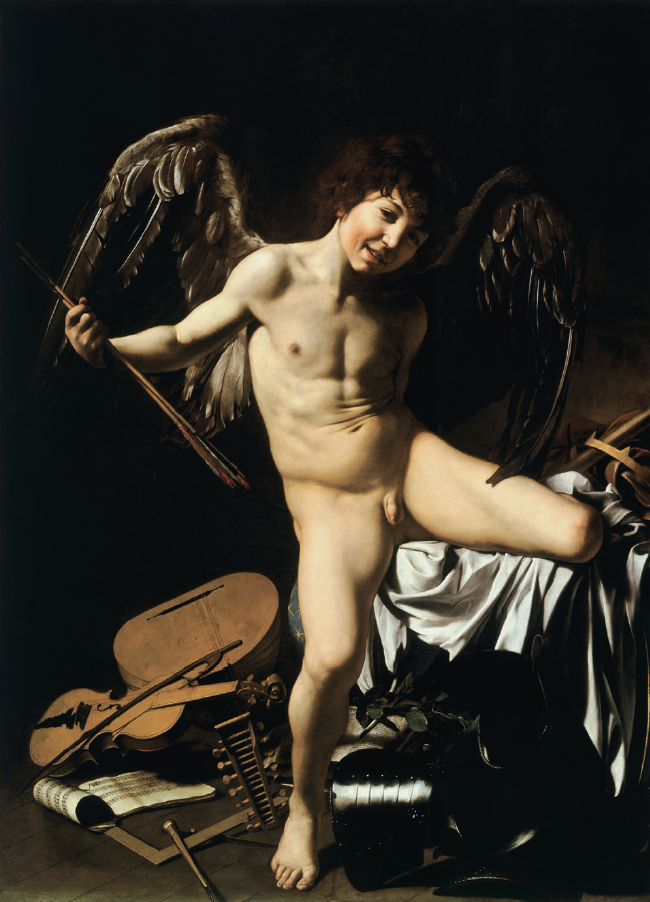
Amor Victorious, 1602
KT: We don’t have to wait for an expert on Italy to tell you about Caravaggio. Like instead of the talk that recently happened, they could interview art history experts in Thailand and the recorded conversations could be played in a loop. This way, through the exhibition, Thai viewers would be able to understand more about different parts of the curated program including the process of art conservation and restoration, and the nature of reproductions. And I think what sums up our conversation here is this quote from Tristram Hunt, Director of the Victoria & Albert “Technology is transforming how audience access and interact with the objects and collections”.

FOOTNOTE
01
Salvatore Settis ประธานคณะกรรมการที่ ปรึกษาด้านวิชาการของพิพิธภัณฑ์ Louvre คนปัจจุบัน ให้มุมมองต่องานก็อปปี้ได้อย่างน่าสนใจ โดยพูดถึง Otsuka Museum บนเกาะ Shikoku ในญี่ปุ่นที่จัดแสดงผลงานก็อปปี้จิตรกรรมตะวันตก ว่าเป็นโอกาสที่ดีในการเรียนรู้ศิลปะสำหรับคนญี่ปุ่นที่อยู่ห่างไกลสถานที่ที่จะได้ชมงานต้นฉบับ และผลลัพธ์ที่ตามมาก็คือ ในจำนวนผู้ชมราวสองแสนคนต่อปีนั้น ไม่ต้องสงสัยเลยว่าจะต้องมีคนที่อยากเห็นงานต้นฉบับในสักวัน สิ่งนี้แสดงให้เราเห็นว่า งานก็อปปี้จะมีคุณค่าก็ต่อเมื่อมันอ้างอิงกลับไปหางานต้นฉบับ ทว่ามันไม่ได้มีคุณค่าในตัวมันเอง อ้างอิงจาก Anna Margherita Jasink, et al (eds.), MUSINT Le Collezioni archeologiche egee e cipriote in Toscana: Ricerche ed esperienze di museologia interattiva, Florence: Firenze University Press, 2011, p.163.
Salvatore Settis, who currently chairs the Scientific Council of the Musée du Louvre, illustrated the advantages of reproductions of artwork by talking about the Otsuka Museum in Shikoku Island, Japan. The reproduction version of these Italian masterpieces provided the Japanese audience with good opportunities to learn about western art instead of traveling to Italy, and, undeniably, some people (from the 200,000+ audience that viewed the reproduction in a year) are looking for the opportunity to see the original works. It is quite obvious that reproduction of the artwork doesn’t contain the same value itself but the essence of a reproduction is its relationship with the original artwork (Anna Margherita Jasink, et al (eds.), MUSINT Le Collezioni archeologiche egee e cipriote in Toscana: Ricerche ed esperienze di museologia interattiva, Florence: Firenze University Press, 2011, p.163.)
02
การบูรณะปฏิสังขรณ์ Sistine Chapel เกิดขึ้นในระหว่างปี 1980-1994 จากเงินสนับสนุนจำนวน 4.2 ล้านดอลลาร์สหรัฐ จาก Nippon Television Network Corporation ที่นำไปสู่ข้อตกลงในการให้สิทธิ์แก่ทางสถานีในการติดตามบันทึกขั้นตอนการทำงานบูรณะครั้งนี้ (ทั้งภาพนิ่งและเคลื่อนไหว) นอกจากมันจะนำไปสู่การทำฐานข้อมูลดิจิตอลความละเอียดสูงสำหรับใช้เป็นตัวอ้างอิงในการซ่อมแซมในอนาคตแล้ว ยังเป็นครั้งแรกของการเปิดเผยกระบวนการทำงานทั้งหมดออกมาให้สาธารณะชนได้เห็นอีกด้วย
The Vatican’s renovation of the Sistine Chapel was supported by Nippon Television Network Corporation for an amount of 4.2 million US dollars. This contribution made Japanese telecomm unications companies able to document entire restoration processes (both of images and video) and distribute them to the public. Not only was it the first time that the public was provided with the whole story behind the restoration of a significant painting, but it also led to the digital archive project and the creation of high-quality reference images that can be used in future restorations
03
CENSUS
โปรเจ็คต์การทำฐานข้อมูลเพื่อการศึกษายุคเรอเนสซองส์อย่างเป็นระบบระเบียบที่เกิดขึ้นในปี 1946 ใน Warburg Institute, London มีจุด ประสงค์เพื่อสนับสนุนศิลปินที่ทำงานเรื่องโลกยุคโบราณ (Antiquity) ในศตวรรษที่ 14 และ 15 ต่อมาในปี 1970 J. Paul Getty Trust ได้ริเริ่มโปรแกรม Art History Information ถ่ายโอนระบบฐานข้อมูลจาก index card เข้าสู่ระบบดิจิตอล และสร้าง data model (ระบบการสืบค้นที่ใกล้เคียงกับอินเตอร์เน็ตแบบปัจจุบัน) เพื่อให้การสืบค้นข้อมูลทำได้คล่องตัวมากขึ้น (www.census.de)
CENSUS
Initiated at Warburg Institute, London, in 1946, Census is a physical database project that aimed to support both the scholars in the field of Renaissance studies and the artists who were working on the Antiquity in the 14th – 15th centuries. In 1970, j.Paul Getty Trust founded the Art History Information, digitizing index card data into a digital format and developing a searching system by creating a ‘data model’ internet linked searching system that allows for users to access data more efficiently (www.census.de)
04
การสร้างโปรดักท์ที่เป็นการผลิตซ้ำจากงานศิลปะ หรือเกี่ยวข้องกับงานศิลปะในคอลเล็คชั่น เช่น แคตตาล็อค โปสเตอร์ ไฟล์ดิจิตอลความละเอียดสูง ถือเป็นหนึ่งรายได้สำคัญในการบริหารจัดการพิพิธภัณฑ์ โดยคิดเป็น 40 เปอร์เซ็นต์ของโครงสร้างรายได้ทั้งหมด รองจากเงินสนับสนุนจากรัฐบาลหรือการหาเงินทุนจากองค์กรเอกชน ซึ่งอยู่ที่ประมาณ 60 เปอร์เซนต์ โมเดลธุรกิจเหล่านี้เกิดขึ้นในเวลาเดียวกันกับที่รัฐบาลหลายๆ ประเทศในยุโรปตัดลดงบประมาณในการจัดการมรดกทางวัฒนธรรม ซึ่งทำให้ภาระค่าใช้จ่ายในการซ่อมแซมชิ้นงานและปรับปรุงระบบอาคารตกอยู่กับพิพิธภัณฑ์ ส่วนรายได้จากตั๋วเข้าพิพิธภัณฑ์ถือเป็นสัดส่วนที่น้อยมาก คือ 2 เปอร์เซ็นต์ (ดู Jenny Gibbs, The Business Model of the Nonprofit Museum, www.sothebysinstitute.com, 2018)
The income from selling catalogues, posters and high-resolution images of the artworks is a significant amount of money (around 40% of the overall income, while the remaining 60% is supported by the government or private sector) that the museum uses for maintenance and to manage the budget. This aforementioned business model was initiated since many governments in Europe lowered cultural and heritage support expenses and museums were forced to take full responsibility for artwork restoration and building maintenance costs due to the fact that income from museum fees is only 2% of their overall income (Jenny Gibbs, The Business Model of the Nonprofit Museum, www.sothebysinstitute.com, 2018)
